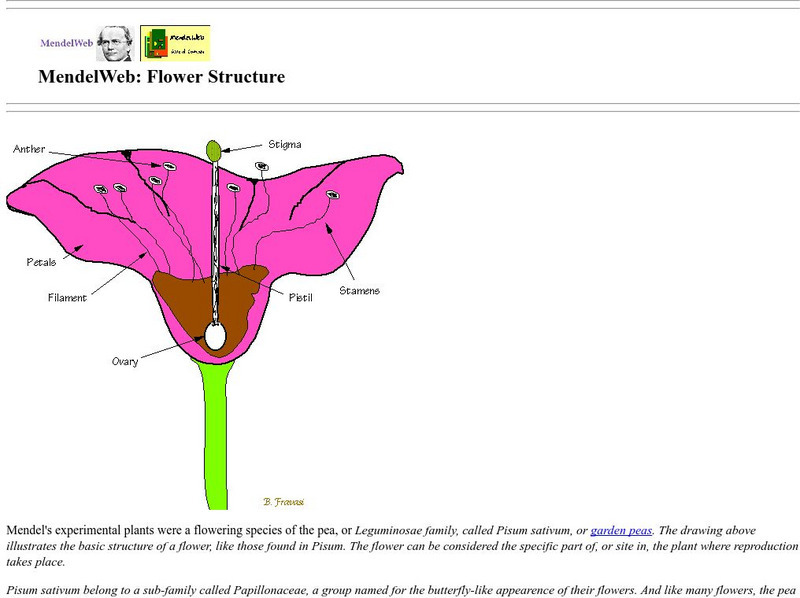Hi, what do you want to do?
Curated OER
Apple Blossoms and Pollination
Students explore the concept of pollination. In this pollination lesson, students examine the parts of an apple blossom and then compare and contrast pollination and cross-pollination.
Curated OER
Let's Learn About Plants!
Students discover different plants and plant parts by observing their campus. In this plant life lesson, students take a guided walk around their school with a magnifying glass examining everyday plants as well as photographing...
Curated OER
Nuts About Peanuts
First graders explore peanuts. In this peanut lesson, 1st graders examine the parts of peanut plants and identify them. Students plant their own peanut plants and chart their growth.
Curated OER
Science Experiment Using Lima Beans
Fourth graders tie together elements about the world and their environment. Students incorporate styles of higher order thinking skills. Students measure skills of observations, conclusions, inferences and predictions.
Bethel School District
Observations and Inference
What's the difference between qualitative and quantitative observations? Learners make observations, inferences, and predictions about their environment with a set of questions and activities that are applicable to either language...
Curated OER
Life Cycles
For this plant life cycle worksheet, students study the diagram of the flower. Students match the term and description that fits each part of the flower.
Curated OER
Botany Basics
Middle schoolers survey plants. In this plant identification lesson, students explore the difference in plants to aid identification. Middle schoolers determine which plants may be used for medicinal reasons.
Curated OER
Rainforest Plant or Animal?
Students explore the major functions of plants and animals. In this rainforest lesson plan students create a Venn diagram to compare and contrast animals in the rainforest.
Federal Reserve Bank
Little Nino's Pizzeria
Engage your youngsters in basic economics by connecting the terms to dessert and pizza! After a discussion about intermediate goods and natural resources, learners read and connect a pizzeria to economic terms.
Curated OER
Trait Variations for Survival
Young learners examine how different traits could give one organism an advantage over another. In groups, they view two different organisms in different environments. To end the lesson, they complete a Venn Diagram on the two organisms...
Curated OER
How Does Your Garden Grow?
Students complete activities to learn about the life cycle of a seed. In this plant growth lesson, students complete activities for the life cycles of seeds.
Curated OER
Optional Laboratory: Soil Particle Size and Texture
Students work together to perform experiments on different types of soil. They record the soil's pH level, color and texture. They develop hypothesis' on what they believe they will discover before beginning the experiment.
Science & Plants for Schools
Science & Plants for Schools: Parts of a Flower
A detailed look at the parts of a plant and how plants reproduce.
Missouri Botanical Garden
Missouri Botanical Garden: Biology of Plants: Pollination
Learn the parts of a flower and how a plant gets pollinated. Includes video, songs, diagrams, and lesson plans.
Mocomi & Anibrain Digital Technologies
Mocomi: Parts of a Flower
An illustrated diagram featuring the male and female parts of a flower.
Soft Schools
Soft Schools: Plant Parts
Identify the major parts of a plant. Select each part name and drop in the boxes next to the full-color diagram.
Other
Mendel Web: Flower Structure
This site presents a diagram of flower, followed by a focus on Gregor Mendel's experiments on a flowering species of the pea.
Soft Schools
Soft Schools: Flower Anatomy
Identify the major parts of a flower. Select each part name and drop in the boxes next to the full-color diagram.
Scholastic
Scholastic: Science Labelling Game
In a series of five interactive science games, students first study labeled diagrams to learn the names of the Earth's layers, of a flower's parts, of a fish's anatomy, of the human respiratory system, and of layers of the atmosphere....
Other
Nature's Partners: Pollinators, Plants, and You [Pdf]
Teachers will love this comprehensive Grades 3-6 curriculum on pollinators. There are six modules of detailed plans and accompanying materials. Pre-assessment activities and teacher background information, as well as supplemental...
HotChalk
Hot Chalk: Lesson Plans Page: Plants and Animals
In this lesson plan, young students will be able to identify a plant's parts, explain their functions, diagram a plant, and create a mobile to demonstrate their understanding.






















